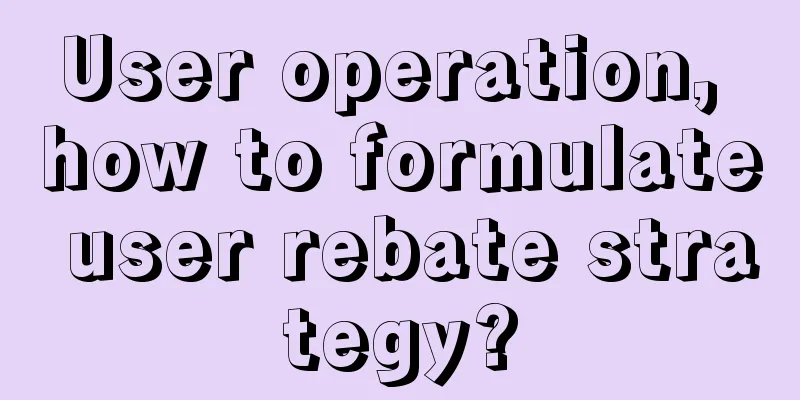How to create highly sticky products? Teach you 3 models

|
What is CLV? You must understand this word when making products. CLV is customer lifetime value, also known as customer life cycle value, which is the abbreviation of Customer Lifetime Value. It means the total value that a user can create for you in his lifetime. In simple terms, it means:
This is CLV, customer lifetime value. (Of course, CLV also includes the indirect value that users create for you.) Once you understand CLV, you will know how important user retention rate is. If users leave as soon as they come, what’s the point of talking about lifetime value? Therefore, we can't help but think about a question: What kind of product can achieve a higher user retention rate? Today, I’m here to talk to you about this. 1.There is a very high level of product development: making the product a habit for users. When a product enters the user's "habit zone", it gains sustained vitality and there is no need to worry about user retention rate . WeChat has done this. Last year, WeChat released a "2017 WeChat Data Report ", which showed that WeChat had 900 million daily active users in September 2017, and WeChat users sent 38 billion messages per day, a year-on-year increase of 25%. WeChat has already formed a habit among its users. So, how can we make a product become a habit for users like WeChat? I found an answer from behavioral science. Cognitive psychologists believe that habit is actually a kind of "unconscious behavior produced by situational cues." This sentence gave me a guess: scene + suggestion = habit formation? In order to verify the correctness of this conjecture, I spent hundreds of hours reading a large amount of domestic and foreign information. This is especially true in the field of behavioral psychology, which studies the scientific secrets behind human behavior. And I highly recommend that everyone learn some behavioral psychology. Because this way you can better understand user psychology. In future articles, I will often talk to you about this knowledge, mainly some research results that can be used in products and operations . So, let’s return to the topic of product habits. How can we make products become users’ habits? I recommend three models to you: 2. The first model: Fogg Behavior Model (also known as FBM model)The model is named after behavioral scientist BJ Fogg, founder of the Stanford Behavioral Design Lab. The first step in shaping user usage habits is to get users moving. How to drive user behavior ? Fogg believes that there are three driving factors behind all human behavior, and these three factors are indispensable to get people to take action. This is the FBM model: Behavior = Motivation + Ability + Trigger. Here are the three necessary conditions for action to occur:
How to understand this model? Let’s take a look at Fogg’s story. Imagine a scenario:
So if we want users to take certain actions, we need to consider designing three action elements in the product: give users a reasonable motivation, reduce user ability barriers, and set effective triggers. This is the core mechanism of Fogg's behavior model. The above is the first model for building product habits: Fogg behavior model - if you want users to develop habits, you must first change their behavior. 3. The Second Model: Hook ModelThe originator of the addiction model is Nir Eyal, who wrote a book, the Chinese version of which is "Addicted: Four Major Product Logics that Help Users Develop Habits". In the addiction model, Nir divides the process of building habits into four stages: trigger, action, variable rewards, and investment.
Through the user's "investment", the next "trigger" may be generated, thus starting a positive cycle, and then you become addicted. This is Nir's addiction model. Based on Fogg's behavioral model, he added more addictive elements to form a positive cycle, allowing the product to guide users to repeat the behavior and eventually form a habit. The above is the second model for building product habits: the addiction model - the cultivation of habits is to let users' behaviors cycle and repeat continuously. 4. The third model: Gamification Octagon ModelWhy are games so addictive? This shows that there must be many addictive elements behind the game design. Game design attaches great importance to human behavioral motivations. It is a people-centered design rather than a function-centered design. So, from the perspective of gamification, I found a good model - the gamification octagon model. The proposer is Yu-kai Chou. He spent ten years studying games and eventually found that the reasons why people love playing games are basically inseparable from eight core driving forces :
These eight core driving forces constitute the gamification design framework. Because it is designed in an octagonal shape and each side represents 1 core driver, this model is called the "Octagonal Model". The above is the third model for building product habits: the gamification octagonal model - insight into core driving forces and enhancing the intrinsic appeal of products. 5. ConclusionTalent belongs to a few, but routines belong to everyone. ——Kangxi's Master Finally, let’s summarize all the content of today: (1) What is CLV? CLV stands for customer lifetime value, which refers to the total value that a user can create for you in his or her lifetime. Once you understand CLV, you will know the importance of user retention rate. (2) What kind of product can achieve a higher user retention rate? There is a very high level of product development: making the product a habit for users. (3) How to make the product become a habit for users? I recommend three models to you:
6. Three things you can do todayToday we are talking about models that trigger actions, so let’s practice them deliberately. Here are three things you can do today:
The author of this article @康熙师爷 is compiled and published by (Qinggua Media). Please indicate the author information and source when reprinting! Product promotion services: APP promotion services, advertising platform, Longyou Games |
<<: [Making a living by speculating in antiques 2007] Dark horse super large band tactics
>>: How to plan an event? Activity planning process conception
Recommend
10 free photo websites you should visit when operating a business. How many have you used?
I started writing for the official account in Aug...
To make high net worth users "addicted", it is enough to grasp these three points
Today we are going to share something very intere...
Lu Feifei_Fei Chang Memory Super Brain Training Camp 34th
Lu Feifei·Fei Chang Memory Super Brain Training C...
Tips for selling goods through short video live streaming
As more and more players join in, e-commerce live...
When it comes to community operations, 80% of people have positioned themselves incorrectly!
80% of the people who create communities do so fo...
How to plan and promote an event?
When it comes to event planning, perhaps in many ...
How can brands take advantage of the Qixi Festival? Here are 6 marketing tips for you!
What are some heartfelt entry points to leverage ...
How to write a good copy that will not be disliked by users?
Just like posting advertising copy in the circle ...
Taking subway ads as an example, let’s talk about NetEase Yanxuan’s copywriting strategy
NetEase Yanxuan is a boutique shopping e-commerce...
How to use Toutiao's recommendation rules to create a hit article with over 1 million readers?
Toutiao has been able to become a disruptor in th...
Home Insurance 20 Lectures
Home Insurance 20 Lectures Resource Introduction:...
How to promote products with the help of KOLs on Xiaohongshu?
With the rise of awareness among the new generati...
Four steps to improve app retention using push notifications
How to improve user retention rate is one of the ...
The secrets you must know about Douyin business operations!
As of November 2018, Douyin has 450 million month...
How to play "618"? Take this advertising guide for free
This year’s “618” mid-year shopping festival coin...









